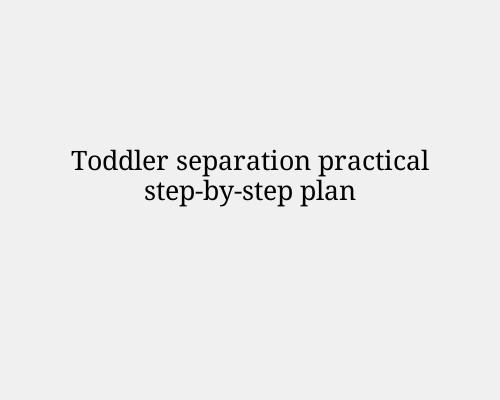
Separation anxiety in toddlers – practical step-by-step plan
Here’s a practical step-by-step plan for easing toddler separation anxiety, broken down into
morning drop-offs, bedtime, and sudden separations.
Morning drop-offs (e.g., day care, preschool, grandparents)
Goal: Build predictability and trust so your toddler feels safe even when you’re away.
Step-by-step:
Prepare the night before
Talk briefly about where they’ll be going and who will care for them. Keep it upbeat.
Pack their bag together so they feel involved.
Keep mornings calm
Avoid rushing – toddlers sense stress.
Use a consistent breakfast and dressing routine.
Do a quick, warm goodbye
Establish a “ritual”: e.g., hug, kiss, high-five, wave at the door.
Keep it under 30 seconds—lingering increases distress.
Leave with confidence
Smile, use a cheerful tone: “Have fun! I’ll be back after story time!”
Avoid sneaking out—it erodes trust.
Bedtime separations
Goal: Help them feel secure enough to fall asleep without you right there.
Step-by-step:
Wind-down routine
Same order every night (e.g., bath → pyjamas → book → cuddle).
Use dim lighting and soft voices.
Comfort item
A favourite blanket, stuffed animal, or nightlight can act as a “stand-in” for your presence.
Gradual retreat
Sit beside their bed until they’re calm, then move further away each night until you can leave before they fall asleep.
Reassuring phrase
Use the same words each night: “I’ll check on you in a little while.”
Follow through—pop in briefly after 5–10 minutes.
Sudden separations (unexpected errands, appointments)
Goal: Minimize anxiety when there’s little preparation time.
Step-by-step:
Simple explanation
“I need to go to the shop. Auntie will play with you until I get back.”
Quick goodbye ritual
Even if rushed, keep the same short routine.
Reunite warmly
Greet with enthusiasm, mention something positive the caregiver told you about their time.
Extra tips for all situations
Name emotions: “You feel sad when I leave. That’s okay. I’ll be back.”
Practice “peek-a-boo” style games – builds trust in “coming back.”
Use a picture of you – toddlers may find comfort holding or seeing it.
Avoid guilt talk – Instead of “Don’t cry,” try “I know you can do this.”